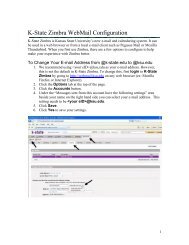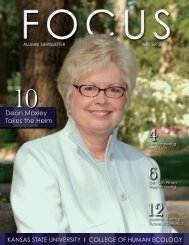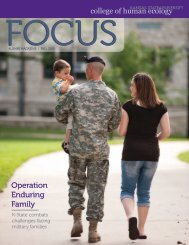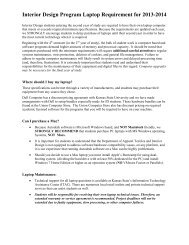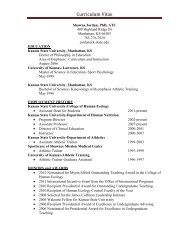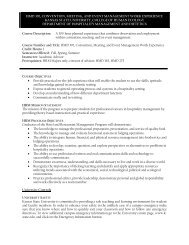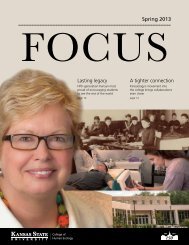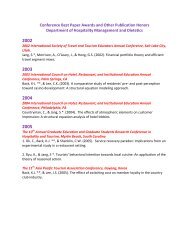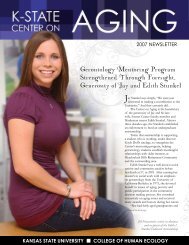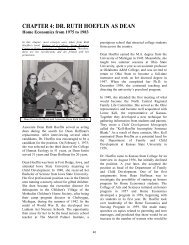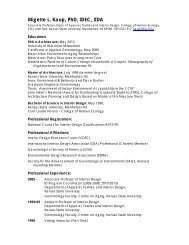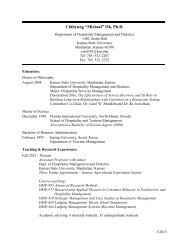Introduction to the MFT Program at K-State (Adobe Acrobat)
Introduction to the MFT Program at K-State (Adobe Acrobat)
Introduction to the MFT Program at K-State (Adobe Acrobat)
Create successful ePaper yourself
Turn your PDF publications into a flip-book with our unique Google optimized e-Paper software.
2010<strong>Introduction</strong> <strong>to</strong> <strong>the</strong> Marriage andFamily Therapy <strong>Program</strong>Doc<strong>to</strong>ral Degree <strong>Program</strong>School of Family Studiesand Human ServicesKansas St<strong>at</strong>e University
INTRODUCTIONThis document serves as an introduction <strong>to</strong> <strong>the</strong>doc<strong>to</strong>ral degree program in marriage and family<strong>the</strong>rapy <strong>at</strong> Kansas St<strong>at</strong>e University. The program isaccredited by <strong>the</strong> Commission on Accredit<strong>at</strong>ion forMarriage and Family Therapy Educ<strong>at</strong>ion (COA<strong>MFT</strong>E),and is one of three doc<strong>to</strong>ral programs in <strong>the</strong> Schoolof Family Studies and Human Services (FSHS).DOCTORAL PROGRAM MISSION ANDEDUCATIONAL OUTCOMESThe mission of Kansas St<strong>at</strong>e University’s PhDprogram is <strong>to</strong> prepare students <strong>to</strong> be excellentclinicians, supervisors, educa<strong>to</strong>rs and researchersworking in a variety of academic and/or clinicalmental health agencies.Students gradu<strong>at</strong>ing from KSU’s Doc<strong>to</strong>ral <strong>Program</strong>in marriage and family <strong>the</strong>rapy will be able <strong>to</strong>demonstr<strong>at</strong>e competence in:A. Marital and Family Therapy. Gradu<strong>at</strong>es willdemonstr<strong>at</strong>e competence in providing marital andfamily <strong>the</strong>rapy <strong>to</strong> individuals, couples, and families.B. Clinical Supervision. Gradu<strong>at</strong>es will demonstr<strong>at</strong>ecompetence in providing clinical supervision <strong>to</strong> <strong>MFT</strong>trainees.C. Teaching. Gradu<strong>at</strong>es will demonstr<strong>at</strong>ecompetence in syn<strong>the</strong>sizing and communic<strong>at</strong>ingrelevant knowledge <strong>to</strong> students, professionals andnonprofessionals.D. Research. Gradu<strong>at</strong>es will be able <strong>to</strong> design,conduct and interpret rel<strong>at</strong>ed <strong>MFT</strong> research.PROGRAM THEORETICAL FOUNDATIONDuring <strong>the</strong>ir time in <strong>the</strong> program, students receivetraining in both classic and cutting‐edge family<strong>the</strong>rapy <strong>the</strong>ories, disorder‐specific approaches, andempirically supported tre<strong>at</strong>ments. The underlyingfound<strong>at</strong>ion for <strong>the</strong> tre<strong>at</strong>ment approaches taught is asystemic and rel<strong>at</strong>ional orient<strong>at</strong>ion <strong>to</strong> problems inliving. In addition, students are expected <strong>to</strong> view <strong>the</strong>process of <strong>the</strong>rapy from a biopsychosocial lens.<strong>MFT</strong> PROGRAM CLIMATEThe <strong>MFT</strong> faculty desire th<strong>at</strong> <strong>the</strong>y and <strong>the</strong> students work<strong>to</strong>ge<strong>the</strong>r <strong>to</strong> cre<strong>at</strong>e a program clim<strong>at</strong>e th<strong>at</strong>:˜ values and affirms diversity˜ is non‐discrimina<strong>to</strong>ry˜ is positive and empowering˜ is safe˜ is supportive˜ is respectfulSTUDENT ASSOCIATION ORGANIZATIONThe Marriage and Family Therapy Student/Associ<strong>at</strong>e Organiz<strong>at</strong>ion is a student‐run campusorganiz<strong>at</strong>ion with a mission <strong>to</strong> assist students as<strong>the</strong>y progress through <strong>the</strong>ir gradu<strong>at</strong>e studies. This isaccomplished by: (1) coordin<strong>at</strong>ing social events <strong>to</strong>help students grow closer <strong>to</strong>ge<strong>the</strong>r and maintainsome balance in <strong>the</strong>ir lives; and (2) providing a voice<strong>to</strong> faculty by raising issues and providing feedbackrelevant <strong>to</strong> improving <strong>the</strong> experience of gradu<strong>at</strong>estudents.<strong>MFT</strong> PROGRAM FACULTYDr. Sandra M. Stith, Professor & <strong>Program</strong> Direc<strong>to</strong>r(785) 532 – 4377; sstith@ksu.eduSandi joined <strong>the</strong> KSU faculty after serving asdirec<strong>to</strong>r of <strong>the</strong> master’s program in <strong>MFT</strong> <strong>at</strong> VirginiaTech. She is a Kansas Licensed Clinical Marriage andFamily Therapist and an AA<strong>MFT</strong> clinical memberand approved supervisor. In 2004 Dr. Stith received<strong>the</strong> American Associ<strong>at</strong>ion for Marriage and FamilyTherapy’s Outstanding Contribution <strong>to</strong> Marriageand Family Therapy Award and in 2007 she received<strong>the</strong> American Family Therapy Associ<strong>at</strong>ion’sDistinguished Contribution <strong>to</strong> Family SystemsResearch Award and Kansas St<strong>at</strong>e University’sDistinguished Alumni Award. Her primary researchinterest is in Intim<strong>at</strong>e Partner Violence and shemanages a research program funded by <strong>the</strong> USAFFamily Advocacy <strong>Program</strong>.
Nancy O’Conner, MS., Clinical Direc<strong>to</strong>r(785) 532‐2220; noconner@ksu.eduNancy is responsible for case management issues,student <strong>the</strong>rapist orient<strong>at</strong>ion and training, qualityassurance review, clinical budget, outreach andcoordin<strong>at</strong>ion of contracts for <strong>the</strong>rapy services with<strong>the</strong> Family Center. She maintains a contract with<strong>the</strong> St<strong>at</strong>e of Kansas providing Home‐Based Family<strong>the</strong>rapy training for <strong>the</strong> Kansas Community mentalhealth centers and priv<strong>at</strong>e contrac<strong>to</strong>rs. Nancy is anAA<strong>MFT</strong> Clinical Member and a Kansas LicensedClinical Marriage and Family Therapist.Dr. Anthony P. Jurich, Professor & AdmissionsCoordina<strong>to</strong>r (785) 532 – 1488; jurich@ksu.eduTony is a Clinical Member and Past President ofAA<strong>MFT</strong>, an AA<strong>MFT</strong> Fellow, an Approved Supervisorand a Kansas Licensed Clinical Marriage and FamilyTherapist. He received <strong>the</strong> NCFR Osborne Award in1987, <strong>the</strong> N<strong>at</strong>ional Member Award from KappaOmicron Nu in 1990 and <strong>the</strong> Kansas Associ<strong>at</strong>ion forMarriage and Family Therapy Service <strong>to</strong> <strong>the</strong>Profession Award in 1997. His specialty areas areadolescence, sex <strong>the</strong>rapy, family crisis and suicide.Dr. Joyce A. Baptist, Assistant Professor(785) 532‐6891; jbaptist@ksu.eduJoyce is a Clinical Member of AA<strong>MFT</strong>, an ApprovedSupervisor, and a Kansas Licensed Clinical Marriageand Family Therapist. She is a consultant <strong>to</strong>counseling agencies in Malaysia and Singapore. Herresearch interests include cross‐cultural couplerel<strong>at</strong>ionships, orphans and families in Africa,immigrant families, and trauma.Dr. Jared R. Anderson, Assistant Professor(785) 532‐4198; jra@ksu.eduJared completed his doc<strong>to</strong>r<strong>at</strong>e from University ofMinnesota in Family Social Science with anemphasis in Marriage and Family Therapy. Hisresearch interests include rel<strong>at</strong>ionship form<strong>at</strong>ionand developmental change in marriage, <strong>the</strong>development and evalu<strong>at</strong>ion of rel<strong>at</strong>ionshipstreng<strong>the</strong>ning programs, families and health, and<strong>the</strong> development of democr<strong>at</strong>ic communityiniti<strong>at</strong>ives. He is an AA<strong>MFT</strong> clinical member andlicensed Marriage and Family Therapist.Dr. Candyce Russell, Professor(785) 532‐1489; crussell@ksu.eduCandy is a Clinical Member of AA<strong>MFT</strong>, an AA<strong>MFT</strong>Past Secretary and an AA<strong>MFT</strong> Fellow. She is also anApproved Supervisor and a Kansas Licensed ClinicalMarriage and Family Therapist. She earned herdoc<strong>to</strong>r<strong>at</strong>e <strong>at</strong> <strong>the</strong> University of Minnesota. Dr.Russell served as <strong>the</strong> Vera Mowery McAninch Chair<strong>at</strong> K‐St<strong>at</strong>e from 1990 until 2006 when she startedfive years of phased retirement. Her specialty areasare <strong>MFT</strong> supervision and training, <strong>the</strong> process ofcouples <strong>the</strong>rapy and chronic illness <strong>to</strong> meaningmaking.GRADUATION REQUIREMENTSAt least 90 credit hours are required for gradu<strong>at</strong>ion.No more than 30 hours may be transferred in <strong>to</strong> <strong>the</strong>program from a master’s degree. In addition, eachstudent will complete ei<strong>the</strong>r a written preliminaryexamin<strong>at</strong>ions or doc<strong>to</strong>ral portfolio, and if necessarysuccessfully defend it. Each student will also workwith <strong>the</strong>ir major professor <strong>to</strong> write a dissert<strong>at</strong>ionand complete an oral defense of <strong>the</strong> dissert<strong>at</strong>ion.O<strong>the</strong>r requirements for gradu<strong>at</strong>ion are listed below:INTERNSHIPStudents must complete a nine‐month rel<strong>at</strong>ionallyfocused clinical and/or research internship.<strong>Program</strong> faculty assist doc<strong>to</strong>ral students in findingan internship site.RESEARCH TEAMSThe Research team experience provides anopportunity <strong>to</strong> work directly with facultyresearchers and student colleagues. These direct
experiences in collabor<strong>at</strong>ive rel<strong>at</strong>ionshipscompliment knowledge and understanding acquiredin coursework. The research team experience canenhance expertise, foster career goals and advanceskills needed for <strong>the</strong> dissert<strong>at</strong>ion. In addition,students may have an opportunity <strong>to</strong> co‐authorpublic<strong>at</strong>ions or conference present<strong>at</strong>ions.SUPERVISION AND CLINICAL REQUIREMENTSAll doc<strong>to</strong>ral students are required <strong>to</strong> be involved inclinical work during <strong>the</strong>ir first two years in <strong>the</strong>program. Students provide <strong>the</strong>rapy <strong>at</strong> <strong>the</strong> FamilyCenter, <strong>the</strong> on‐campus <strong>MFT</strong> clinic. The facilityincludes 5 <strong>the</strong>rapy rooms and a large group room.All rooms have one‐way mirrors and st<strong>at</strong>e‐of‐<strong>the</strong>artaudiovisual equipment. In addition, <strong>the</strong>re areopportunities for practicum placements <strong>at</strong> a varietyof social service agencies in <strong>the</strong> area, including aregional medical center and o<strong>the</strong>r facilities servingmedically underserved popul<strong>at</strong>ions.During <strong>the</strong>ir second year students are required <strong>to</strong>supervise master’s students under <strong>the</strong> supervisionof <strong>the</strong> <strong>MFT</strong> Faculty who are AA<strong>MFT</strong> ApprovedSupervisors.Students must accrue 1,000 clinical contact hours inorder <strong>to</strong> gradu<strong>at</strong>e from <strong>the</strong> program (includingequivalent hours obtained during <strong>the</strong> student’smaster’s degree program).DOCTORAL PORTFOLIODoc<strong>to</strong>ral students have <strong>the</strong> option of completing apreliminary exam or of developing a portfoliodocumenting <strong>the</strong>ir proficiency in research,present<strong>at</strong>ions, teaching and/or outreach, andleadership. Students choosing <strong>the</strong> portfolio arerequired <strong>to</strong> include in <strong>the</strong>ir portfolio evidence ofsuccess in four areas: 1) public<strong>at</strong>ions ‐ one articlewhich <strong>the</strong>y authored or co‐authored which waspublished in a peer‐reviewed journal and one articlesubmitted with positive review; 2) Present<strong>at</strong>ions ‐2‐3 peer –reviewed present<strong>at</strong>ions <strong>at</strong> professionalconferences; 3) Teaching and/or outreach ‐ twoacademic courses, or 6‐10 present<strong>at</strong>ions for a localsocial service agency, or evidence of ongoing workwith a specialized popul<strong>at</strong>ion; 4) Leadership ‐maintain professional membership, pass n<strong>at</strong>ionalL<strong>MFT</strong> exam, and two additional activities, forexample, review <strong>at</strong> least one manuscript for aprofessional journal, serve as a proposal reviewerfor a st<strong>at</strong>e or n<strong>at</strong>ional conference, membership onorganiz<strong>at</strong>ional boards, volunteer work <strong>at</strong>professional conferences, etc.Once <strong>the</strong> portfolio has been completed, <strong>the</strong> studentmust complete a defense of <strong>the</strong> portfolio with <strong>the</strong>student’s committee. The full committee will <strong>the</strong>ndetermine if <strong>the</strong> student has successfully completed<strong>the</strong> KSU doc<strong>to</strong>ral portfolio requirements.Students choosing <strong>to</strong> complete a written preliminaryexamin<strong>at</strong>ion, additionally, will need <strong>to</strong> completeboth teaching practicum and professionaldevelopment.TEACHING PRACTICUMStudents complete <strong>the</strong> teaching practicum byserving as a GTA, teaching an intersession course orenrolling in and completing Principles of CollegeTeaching. However, <strong>the</strong>se are only guidelines and acontract will be developed with <strong>the</strong> academicadvisor tailored <strong>to</strong> <strong>the</strong> student’s preferences andcareer goals.PROFESSIONAL DEVELOPMENTStudents can present a poster / paper <strong>at</strong> a st<strong>at</strong>e,n<strong>at</strong>ional or intern<strong>at</strong>ional conference, develop andpresent a workshop or get involved in KA<strong>MFT</strong>politics. However, <strong>the</strong>se are only guidelines and acontract will be developed with <strong>the</strong> academicadvisor tailored <strong>to</strong> <strong>the</strong> student’s preferences andcareer goals.A SAMPLE PROGRAM OF STUDYBelow is a sample plan for completing <strong>the</strong> doc<strong>to</strong>raldegree in marriage and family <strong>the</strong>rapy. This is not <strong>the</strong>only way <strong>to</strong> complete <strong>the</strong> program. Vari<strong>at</strong>ions incourse scheduling, future plans, and previouscoursework should be considered when using thisplan. The core doc<strong>to</strong>ral courses are offered everyo<strong>the</strong>r year, so <strong>the</strong> order of <strong>the</strong> program of studydepends on when <strong>the</strong> program is started, an odd oreven year.There are a number of courses within FSHS or o<strong>the</strong>rdepartments on campus th<strong>at</strong> will enhance <strong>the</strong> <strong>Program</strong>of Study. Because some of <strong>the</strong>se courses are alsotaught only one semester in each given academic yearor in altern<strong>at</strong>e years, be certain <strong>to</strong> discuss choices of<strong>the</strong>se courses with <strong>the</strong> advisor.
Fall 2010 PhD Cohort Sample <strong>Program</strong> of StudyNOTE: This sample program assumes <strong>the</strong> student is employed 10‐20 hours a week.FIRST FALL (12 CREDITS)FSHS 983 <strong>MFT</strong> Research (3) FSHS 806 St<strong>at</strong>istical Methods in FSHS I (3)FSHS 985 Practicum (3) FSHS 902 Qualit<strong>at</strong>ive Research Methods in FSHS (3)FIRST SPRING (9 CREDITS)FSHS 985 Practicum (3)FSHS 906 St<strong>at</strong>istical Methods in FSHS II (3)FSHS 987 Advanced Clinical Theory (3)FIRST SUMMER (9 CREDITS)FSHS 970 Clinical Specializ<strong>at</strong>ion in <strong>MFT</strong> (3) FSHS 985 Practicum (3)SECOND FALL (9 CREDITS)FSHS 984 Supervision of <strong>MFT</strong> (3) FSHS 986 Practicum in Supervision of <strong>MFT</strong> (3)SECOND SPRING (6 CREDITS)FSHS 986 Practicum in Supervision of <strong>MFT</strong> (3) FSHS 950 Advanced Family Theory (3)SECOND SUMMER (13 CREDITS)COMPLETE AND PASS PRELIMINARY EXAMINATION OR DOCTORAL PORTFOLIOTHIRD FALL (11 CREDITS)BEGIN INTERNSHIP FSHS 990 Dissert<strong>at</strong>ion Proposal Seminar (1)THIRD SPRING (10 CREDIT HOURS)COMPLETE INTERNSHIPAll doc<strong>to</strong>ral students must complete <strong>the</strong> following before gradu<strong>at</strong>ion:• FSHS 892 Practicum in <strong>MFT</strong> Research (3)• FSHS 999 PhD Research in FSHS (30)• 1,000 client contact hours, including hours earned in accredited master’s degree• At least 90 credit hours are required for gradu<strong>at</strong>ion. No more than 30 credit hours from amaster’s degree may be applied <strong>to</strong> fulfill this.• Pass a written Preliminary Examin<strong>at</strong>ion or successfully complete a Portfolio• Professional Development Project (<strong>to</strong> be discussed and finalized with your major professor if notcompleting portfolio)• Teaching Practicum Project (<strong>to</strong> be discussed and finalized with your major professor if notcompleting portfolio)• At least 6 credit hours of 2 Research electives or 1 research elective and 1 clinical elective.• A nine month clinical internship• A dissert<strong>at</strong>ion proposal seminar, write a dissert<strong>at</strong>ion and complete an oral defense of <strong>the</strong>dissert<strong>at</strong>ion.
<strong>MFT</strong> Research Teams OpportunitiesFall 2010 and Spring 2011Faculty Topic Participant duties Present<strong>at</strong>ions andpublic<strong>at</strong>ionsStith/Amanor-BoaduStithImpact of culture on <strong>the</strong>rapy(Series of interviews withfive couples of color and<strong>the</strong>ir <strong>the</strong>rapists on <strong>the</strong>impact of culture on<strong>the</strong>rapy)Client/<strong>the</strong>rapist perspectiveson systemic tre<strong>at</strong>ment ofdomestic violence (series ofinterviews with clients and<strong>the</strong>rapists in conjoint DVtre<strong>at</strong>ment program)• Reviewing liter<strong>at</strong>ure• Analyzing d<strong>at</strong>a• Writing journal article• Reviewing liter<strong>at</strong>ure• Analyzing d<strong>at</strong>a• Writing journal article• AA<strong>MFT</strong>present<strong>at</strong>ion• Journal article• AA<strong>MFT</strong>present<strong>at</strong>ion• Journal articleStithHow highly successful <strong>MFT</strong>researchers developed areaof specializ<strong>at</strong>ion• Reviewing liter<strong>at</strong>ure• Coding d<strong>at</strong>a• Analyzing d<strong>at</strong>a• Writing journal article• AA<strong>MFT</strong>present<strong>at</strong>ion• Journal articleStithUnderstanding collegestudents decision-makingregarding condom use• Reviewing liter<strong>at</strong>ure• Collecting d<strong>at</strong>a (survey andinterview)• Analyzing d<strong>at</strong>a• Writing journal article• NCFR present<strong>at</strong>ion• Journal ArticleJurichP<strong>at</strong>terns of quality of lifeover <strong>the</strong> course of <strong>the</strong>rapy• Writing liter<strong>at</strong>ure review• Write a discussion of <strong>the</strong> results• Journal articleAnderson,Amanor‐Boadu, StithCorrel<strong>at</strong>es of committingsuicide as described byaccidental survivors ofsuicideResiliency in Air ForceCouples FollowingDeployment• Writing liter<strong>at</strong>ure review• Writing discussion for a paper• Transcribing qualit<strong>at</strong>iveinterviews• Coding & Analyzing d<strong>at</strong>a• Reviewing liter<strong>at</strong>ure• Writing journal article• Journal article• Present<strong>at</strong>ion• Journal articleAndersonDevelopment of Young AdultRomantic Rel<strong>at</strong>ionships inChina• D<strong>at</strong>a Entry• Reviewing liter<strong>at</strong>ure• Writing journal article• Present<strong>at</strong>ion• Journal articleAndersonD<strong>at</strong>ing Violence in YoungAdult RomanticRel<strong>at</strong>ionships in China• D<strong>at</strong>a Entry• Reviewing liter<strong>at</strong>ure• Writing journal article• Present<strong>at</strong>ion• Journal article
BaptistCross cultural study ofrel<strong>at</strong>ionship maintenancebehaviors and conflict inrel<strong>at</strong>ionships• Review liter<strong>at</strong>ure• Contribute <strong>to</strong> questions• Collect d<strong>at</strong>a• Clean and analyze d<strong>at</strong>a• Write lit review and discussionsections of a paper.• Journal article• Present<strong>at</strong>ionBaptistIntergener<strong>at</strong>ionaltransmission of<strong>at</strong>tachment and rel<strong>at</strong>ionalbehaviors from parent <strong>to</strong>adult child• Review liter<strong>at</strong>ure• Analyze d<strong>at</strong>a• Write journal article• Journal article• Present<strong>at</strong>ionMacchi &O’ConnerArchuletaTherapist supervision andself-care supporting homebasedfamily <strong>the</strong>rapy(HBFT)Are solution focused <strong>the</strong>rapytechniques effective in afinancial counseling setting?• Reviewing liter<strong>at</strong>ure• Analyzing d<strong>at</strong>a• Writing journal article• Reviewing liter<strong>at</strong>ure• Recruiting subjects• Completion of tre<strong>at</strong>mentmanual• Journal article• Conferencepresent<strong>at</strong>ion• Journal article





